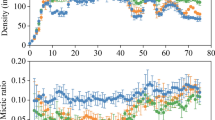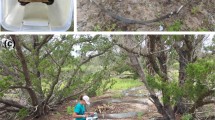Abstract
Weather often subjects overwintering small invertebrates to heavy losses and forces survivors emerging from the litter to respond quickly to achieve short-term success. On spring emergence both feeding and predator avoidance may compete for immediate attention. Caterpillars of the shelter-building fern moth Herpetogramma theseusalis suffer high mortality while overwintering in the litter, and survivors often emerge in parlous condition, thus facing urgent pressure both to feed and to seek protection, since they experience predation and parasitism as well. Accordingly, I addressed whether they prioritized feeding or shelter-building upon emergence. Caterpillars built shelters during the night of their emergence, and many remained in these shelters for five days or more, though a minority soon abandoned their initial sites, presumably to build a subsequent shelter. If I removed their shelter, caterpillars built replacements before feeding, even though losing 10% or more of their mass in the process. Some completed up to five shelters following repeated removals, losing up to half of their mass, including several that died. Subsequently-built shelters declined to as little as one-third their original volume. Thus, they prioritized shelter production over feeding, notwithstanding the high cost in lost growth and time. In contrast, caterpillars not building shelters gained 37–44% in mass/day. Although some of these manipulations exceeded the normal experience, they illustrate the strength of selection favoring protection.




Similar content being viewed by others
Data Availability
Data are available upon request from DHM.
References
Abarca M, Bodge K (2011) Fitness costs and benefits of shelter-building and leaf trenching behaviour in a pyralid caterpillar. Ecol Entomol 36:564–573
Abarca M, Lill JT (2015) Warming affects hatching time and early survival of eastern tent caterpillars. Oecologia 179:901–912
Baer CS, Marquis RJ (2021) Experimental shelter-switching shows shelter type alters predation on caterpillars (Hesperiidae). Behav Ecol 32:1012–1021
Bale JS, Hayward SAL (2010) Insect overwintering in a changing climate. J Exp Biol 213:980–994
Bednekoff PA (2007) Foraging in the face of danger. In: Stephens DW, Brown JS, Ydenberg RC (eds) Foraging: behavior and ecology. University of Chicago Press, Chicago, IL, USA, pp 305–329
Benrey B, Denno RF (1997) The slow-growth-high-mortality hypothesis: a test using the cabbage butterfly. Ecology 78:987–999
Berenbaum MR, Green ES, Zangerl AR (1993) Web costs and web defense in the parsnip webworm (Lepidoptera: Oecophoridae). Environ Entomol 22:791–795
Bernays EA (1993) Feeding by lepidopteran larvae is dangerous. Ecol Entomol 22:121–123
Damman H (1987) Leaf quality an enemy avoidance by the larvae of a pyralid moth. Ecology 68:88–97
Danks HV (1996) The wider integration of studies of insect coldhardiness. Europ J Entomol 93:383–403
Feeny PP (1970) Seasonal changes in oak leaf tannins and nutrients as a cause of spring feeding by winter moth caterpillars. Ecology 51:565–581
Filazzola A, Matter ASF, MacIvor JS (2021) The direct and indirect effects of extreme climate events on insects. Sci Total Environ 769:145161
Fukui A (2001) Indirect interactions mediated by leaf-shelters in animal-plant communities. Popul Ecol 43:31–40
Han E, Bauce E (1998) Timing of diapause initiation, metabolic changes and overwintering survival of the spruce budworm, Choristoneura fumiferana. Ecol Entomol 23:160–167
Heinrich B (1993) How avian predators constrain caterpillar foraging. In: Stamp NE, Casey TM (eds) Caterpillars: ecological and evolutionary constraints on foraging. Chapman & Hall, New York, pp 224–247
Hunter MD (1990) Differential susceptibility to variable plant phenology and its role in competition between two insect herbivores on oak. Ecol Entomol 15:401–408
Hunter MD, Willmer PG (1989) The potential for interspecific competition between two abundant defoliators on oak: leaf damage and habitat quality. Ecol Entomol 14:267–277
Krimmel BA, Morse DH (2019) Host-size decisions of female parasitoid wasps seeking hidden hosts. Ecol Entomol 44:552–559
Leather SR, Walters KFA, Bale JS (1993) The ecology of insect overwintering. Cambridge University Press, New York, NY, USA
Lill JT, Marquis RJ (2007) Microhabitat manipulation: ecosystem engineering by shelter-building insects. In: Cuddington K, Byers JE, Wilson WG, Hastings A (eds) Ecosystem engineers: plants to protists. Academic Press, Burlington, pp 107–138
Lill JT, Marquis RJ, Walker MA, Peterson L (2007) Ecological consequences of shelter sharing by leaf-tying caterpillars. Entomol Exp Applic 124:45–53
Lima SL, Dill LM (1990) Behavioral decisions made under the risk of predation: a review and prospectus. Can J Zool 68:619–640
Loeffler CC (1996) Adaptive trade-offs of leaf folding in Dichomeris caterpillars on goldenrods. Ecol Entomol 21:34–40
Marshall KE, Sinclair BJ (2012a) The impacts of repeated cold exposure on insects. J Exp Biol 215:1607–1613
Marshall KE, Sinclair BJ (2012b) Threshold temperatures mediate the impact of reduced snow cover on overwintering freeze-tolerant caterpillars. Naturwissenschaften 99:33–41
Morse DH (2007) Predator upon a flower. Life history and fitness in a crab spider. Harvard University Press, Cambridge, MA, USA
Morse DH (2011) Size and development time of herbivorous host and parasitoid on distantly related foodplants. Am Midl Nat 166:252–265
Morse DH (2012) Reproductive output of a female crab spider: the impacts of mating failure, natural enemies, and resource availability. Entomol Exp Applic 146:141–148
Morse DH (2017) Where should I lay my eggs? Oviposition choices of a moth and the shifting danger of being parasitized. Entomol Exp Applic 165:1–8
Morse DH (2020) Spider use of caterpillar shelters. J Arachnol 48:284–287
Morse DH (2021a) Rapid phenological change differs across four trophic levels over 15 years. Oecologia 196:577–587
Morse DH (2021b) Rapid decline of a four-trophic-level system over a 15-year period. Oecologia 197:785–793
Morse DH, Chapman GH (2015) Growth, development and behaviour of the parasitised and unparasitised larvae of a shelter-building moth and consequences for the resulting koinobiont parasitoid. Entomol Exp Applic 154:179–187
Murphy SM, Lill JT (2010) Winter predation of diapausing cocoons of slug caterpillars (Lepidoptera: Limacodidae). Environ Entomol 39:1893–1902
Nakamura M, Ohgushi T (2003) Positive and negative effects of leaf shelters on herbivorous insects: linking multiple herbivore species on a willow. Oecologia 136:445–449
Nielsen ME, Lehmann P, Gotthard K (2022) Longer and warmer prewinter periods reduce post-winter fitness in a diapausing insect. Funct Ecol 36:1151–1162
R Development Core Team (2021) R: a language and environment for statistical computing. R Foundation for Statistical Computing, Vienna, Austria
Roberts KT, Rank NE, Dahlhoff EP, Stillman JH, Williams CM (2021) Snow modulates winter energy use and cold exposure across an elevation gradient in a montane ectotherm. Glob Change Biol 27:603–626
Rose NH, Halitschke R, Morse DH (2015) Direct and indirect effects of plant defences vary across development in a shelter-building moth larva and its parasitoid. PLoS ONE 10(3):e0120769
Sigmon E (2015) Interspecific variation in aggressive behavior of shelter-building caterpillars. J Ins Behav 28:403–416
Sinclair BJ (2015) Linking energetics and overwintering in temperate insects. J Therm Biol 54:5–11
Sinclair BJ, Vernon P, Klok CJ, Chown SL (2003) Insects at low temperatures: an ecological perspective. Trends Ecol Evol 18:257–262
Sliwinski M, Sigmon E (2013) Why do leaf-tying caterpillars abandon their leaf ties? PeerJ 1:e173. https://doi.org/10.7717/peerj.173
Teets NM, Hayward SAL (2021) Editorial on combatting the cold: comparative physiology of low temperature and related stressors in arthropods. Comp Biochem Physiol Part A 260:111037
Uelmen JA, Lindroth RL, Tobin PC, Reich PB, Schwartzberg G, Raffa KF (2016) Effects of winter temperatures, spring degree-day accumulation, and insect population source on phenological synchrony between forest tent caterpillar and host trees. For Ecol Manag 362:241–250
Webb MR, Pullin AS (1998) Effects of submergence by winter floods on diapausing caterpillars of a wetland butterfly, Lycaena dispar batavus. Ecol Entomol 23:96–99
Weiss MR, Lind DM, Jones MT, Long JD, Maupin JL (2003) Uniformity of leaf shelter construction by early-instar larvae of Epargyreus clarus (Hesperiidae), the silver-spotted skipper. J Ins Behav 16:465–480
Williams CM, Henry HAL, Sinclair BJ (2015) Cold truths: how winter drives responses of terrestrial organisms to climate change. Biol Rev 90:214–235
Acknowledgements
I thank S.A. Adams, E.F. LoPresti, E.K Morse and N. H. Rose for assistance in the field. K.J. Eckelbarger, L. Healy, H.M. Leslie, T.E. Miller, M. Norwood and other staff members of the Darling Marine Center of the University of Maine facilitated fieldwork on their premises.
Funding
Supported by the author.
Author information
Authors and Affiliations
Contributions
All parts of the manuscript written and prepared by the author.
Corresponding author
Ethics declarations
Competing Interests
The authors declare no competing interests.
Conflict of Interest
The author declares no conflict of interest.
Additional information
Publisher’s Note
Springer Nature remains neutral with regard to jurisdictional claims in published maps and institutional affiliations.
Rights and permissions
Springer Nature or its licensor (e.g. a society or other partner) holds exclusive rights to this article under a publishing agreement with the author(s) or other rightsholder(s); author self-archiving of the accepted manuscript version of this article is solely governed by the terms of such publishing agreement and applicable law.
About this article
Cite this article
Morse, D.H. Factors Confronting a Shelter-Building Caterpillar at Spring Emergence. J Insect Behav 36, 247–257 (2023). https://doi.org/10.1007/s10905-023-09835-6
Received:
Revised:
Accepted:
Published:
Issue Date:
DOI: https://doi.org/10.1007/s10905-023-09835-6




